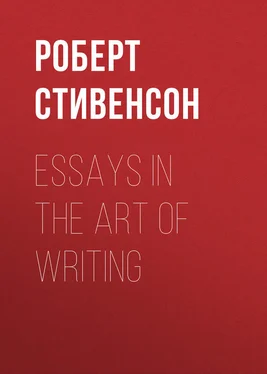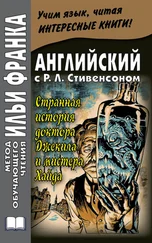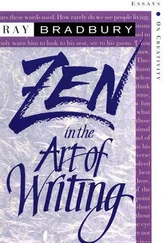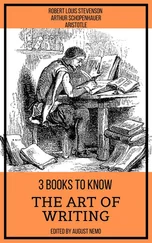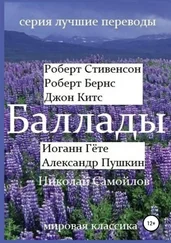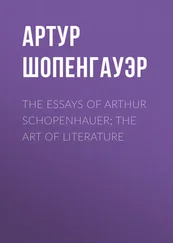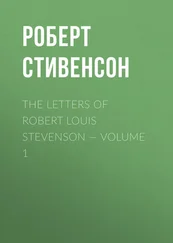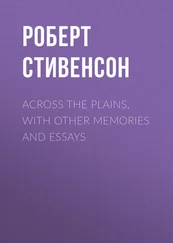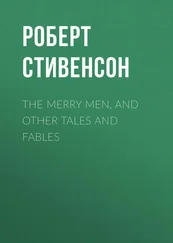Роберт Стивенсон - Essays in the Art of Writing
Здесь есть возможность читать онлайн «Роберт Стивенсон - Essays in the Art of Writing» — ознакомительный отрывок электронной книги совершенно бесплатно, а после прочтения отрывка купить полную версию. В некоторых случаях можно слушать аудио, скачать через торрент в формате fb2 и присутствует краткое содержание. Жанр: literature_19, foreign_antique, foreign_prose, essays, на английском языке. Описание произведения, (предисловие) а так же отзывы посетителей доступны на портале библиотеки ЛибКат.
- Название:Essays in the Art of Writing
- Автор:
- Жанр:
- Год:неизвестен
- ISBN:нет данных
- Рейтинг книги:4 / 5. Голосов: 1
-
Избранное:Добавить в избранное
- Отзывы:
-
Ваша оценка:
- 80
- 1
- 2
- 3
- 4
- 5
Essays in the Art of Writing: краткое содержание, описание и аннотация
Предлагаем к чтению аннотацию, описание, краткое содержание или предисловие (зависит от того, что написал сам автор книги «Essays in the Art of Writing»). Если вы не нашли необходимую информацию о книге — напишите в комментариях, мы постараемся отыскать её.
Essays in the Art of Writing — читать онлайн ознакомительный отрывок
Ниже представлен текст книги, разбитый по страницам. Система сохранения места последней прочитанной страницы, позволяет с удобством читать онлайн бесплатно книгу «Essays in the Art of Writing», без необходимости каждый раз заново искать на чём Вы остановились. Поставьте закладку, и сможете в любой момент перейти на страницу, на которой закончили чтение.
Интервал:
Закладка:
Robert Louis Stevenson
Essays in the Art of Writing
ON SOME TECHNICAL ELEMENTS OF STYLE IN LITERATURE 1 1 First published in the Contemporary Review, April 1885
There is nothing more disenchanting to man than to be shown the springs and mechanism of any art. All our arts and occupations lie wholly on the surface; it is on the surface that we perceive their beauty, fitness, and significance; and to pry below is to be appalled by their emptiness and shocked by the coarseness of the strings and pulleys. In a similar way, psychology itself, when pushed to any nicety, discovers an abhorrent baldness, but rather from the fault of our analysis than from any poverty native to the mind. And perhaps in æsthetics the reason is the same: those disclosures which seem fatal to the dignity of art seem so perhaps only in the proportion of our ignorance; and those conscious and unconscious artifices which it seems unworthy of the serious artist to employ were yet, if we had the power to trace them to their springs, indications of a delicacy of the sense finer than we conceive, and hints of ancient harmonies in nature. This ignorance at least is largely irremediable. We shall never learn the affinities of beauty, for they lie too deep in nature and too far back in the mysterious history of man. The amateur, in consequence, will always grudgingly receive details of method, which can be stated but never can wholly be explained; nay, on the principle laid down in Hudibras , that
‘Still the less they understand,
The more they admire the sleight-of-hand,’
many are conscious at each new disclosure of a diminution in the ardour of their pleasure. I must therefore warn that well-known character, the general reader, that I am here embarked upon a most distasteful business: taking down the picture from the wall and looking on the back; and, like the inquiring child, pulling the musical cart to pieces.
1. Choice of Words . – The art of literature stands apart from among its sisters, because the material in which the literary artist works is the dialect of life; hence, on the one hand, a strange freshness and immediacy of address to the public mind, which is ready prepared to understand it; but hence, on the other, a singular limitation. The sister arts enjoy the use of a plastic and ductile material, like the modeller’s clay; literature alone is condemned to work in mosaic with finite and quite rigid words. You have seen these blocks, dear to the nursery: this one a pillar, that a pediment, a third a window or a vase. It is with blocks of just such arbitrary size and figure that the literary architect is condemned to design the palace of his art. Nor is this all; for since these blocks, or words, are the acknowledged currency of our daily affairs, there are here possible none of those suppressions by which other arts obtain relief, continuity, and vigour: no hieroglyphic touch, no smoothed impasto, no inscrutable shadow, as in painting; no blank wall, as in architecture; but every word, phrase, sentence, and paragraph must move in a logical progression, and convey a definite conventional import.
Now the first merit which attracts in the pages of a good writer, or the talk of a brilliant conversationalist, is the apt choice and contrast of the words employed. It is, indeed, a strange art to take these blocks, rudely conceived for the purpose of the market or the bar, and by tact of application touch them to the finest meanings and distinctions, restore to them their primal energy, wittily shift them to another issue, or make of them a drum to rouse the passions. But though this form of merit is without doubt the most sensible and seizing, it is far from being equally present in all writers. The effect of words in Shakespeare, their singular justice, significance, and poetic charm, is different, indeed, from the effect of words in Addison or Fielding. Or, to take an example nearer home, the words in Carlyle seem electrified into an energy of lineament, like the faces of men furiously moved; whilst the words in Macaulay, apt enough to convey his meaning, harmonious enough in sound, yet glide from the memory like undistinguished elements in a general effect. But the first class of writers have no monopoly of literary merit. There is a sense in which Addison is superior to Carlyle; a sense in which Cicero is better than Tacitus, in which Voltaire excels Montaigne: it certainly lies not in the choice of words; it lies not in the interest or value of the matter; it lies not in force of intellect, of poetry, or of humour. The three first are but infants to the three second; and yet each, in a particular point of literary art, excels his superior in the whole. What is that point?
2. The Web . – Literature, although it stands apart by reason of the great destiny and general use of its medium in the affairs of men, is yet an art like other arts. Of these we may distinguish two great classes: those arts, like sculpture, painting, acting, which are representative, or, as used to be said very clumsily, imitative; and those, like architecture, music, and the dance, which are self-sufficient, and merely presentative. Each class, in right of this distinction, obeys principles apart; yet both may claim a common ground of existence, and it may be said with sufficient justice that the motive and end of any art whatever is to make a pattern; a pattern, it may be, of colours, of sounds, of changing attitudes, geometrical figures, or imitative lines; but still a pattern. That is the plane on which these sisters meet; it is by this that they are arts; and if it be well they should at times forget their childish origin, addressing their intelligence to virile tasks, and performing unconsciously that necessary function of their life, to make a pattern, it is still imperative that the pattern shall be made.
Music and literature, the two temporal arts, contrive their pattern of sounds in time; or, in other words, of sounds and pauses. Communication may be made in broken words, the business of life be carried on with substantives alone; but that is not what we call literature; and the true business of the literary artist is to plait or weave his meaning, involving it around itself; so that each sentence, by successive phrases, shall first come into a kind of knot, and then, after a moment of suspended meaning, solve and clear itself. In every properly constructed sentence there should be observed this knot or hitch; so that (however delicately) we are led to foresee, to expect, and then to welcome the successive phrases. The pleasure may be heightened by an element of surprise, as, very grossly, in the common figure of the antithesis, or, with much greater subtlety, where an antithesis is first suggested and then deftly evaded. Each phrase, besides, is to be comely in itself; and between the implication and the evolution of the sentence there should be a satisfying equipoise of sound; for nothing more often disappoints the ear than a sentence solemnly and sonorously prepared, and hastily and weakly finished. Nor should the balance be too striking and exact, for the one rule is to be infinitely various; to interest, to disappoint, to surprise, and yet still to gratify; to be ever changing, as it were, the stitch, and yet still to give the effect of an ingenious neatness.
The conjurer juggles with two oranges, and our pleasure in beholding him springs from this, that neither is for an instant overlooked or sacrificed. So with the writer. His pattern, which is to please the supersensual ear, is yet addressed, throughout and first of all, to the demands of logic. Whatever be the obscurities, whatever the intricacies of the argument, the neatness of the fabric must not suffer, or the artist has been proved unequal to his design. And, on the other hand, no form of words must be selected, no knot must be tied among the phrases, unless knot and word be precisely what is wanted to forward and illuminate the argument; for to fail in this is to swindle in the game. The genius of prose rejects the cheville no less emphatically than the laws of verse; and the cheville , I should perhaps explain to some of my readers, is any meaningless or very watered phrase employed to strike a balance in the sound. Pattern and argument live in each other; and it is by the brevity, clearness, charm, or emphasis of the second, that we judge the strength and fitness of the first.
Читать дальшеИнтервал:
Закладка:
Похожие книги на «Essays in the Art of Writing»
Представляем Вашему вниманию похожие книги на «Essays in the Art of Writing» списком для выбора. Мы отобрали схожую по названию и смыслу литературу в надежде предоставить читателям больше вариантов отыскать новые, интересные, ещё непрочитанные произведения.
Обсуждение, отзывы о книге «Essays in the Art of Writing» и просто собственные мнения читателей. Оставьте ваши комментарии, напишите, что Вы думаете о произведении, его смысле или главных героях. Укажите что конкретно понравилось, а что нет, и почему Вы так считаете.
